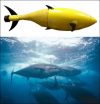(Press-News.org) Pasadena, CA— With the combined power of NASA's Spitzer and Hubble Space Telescopes, as well as a cosmic magnification effect, a team of astronomers, including Carnegie's Daniel Kelson, have spotted what could be the most distant galaxy ever seen. Light from the young galaxy captured by the orbiting observatories was emitted when our 13.7-billion-year-old universe was just 500 million years old. Their work is published September 20 by Nature.
The far-off galaxy existed within an important era when the universe just emerged from the so-called cosmic Dark Ages. During this period, the universe went from a dark, starless expanse to a recognizable cosmos full of galaxies. The discovery of the faint, small galaxy therefore opens up a window into the deepest, remotest epochs of cosmic history.
"This galaxy is the most distant object we have ever observed with high confidence," said lead author Wei Zheng of Johns Hopkins University. "Future work involving this galaxy—as well as others like it that we hope to find— will allow us to study the universe's earliest objects and how the Dark Ages ended."
Light from the primordial galaxy traveled approximately 13.2 billion light-years before reaching NASA's telescopes. In other words, the starlight snagged by Hubble and Spitzer left the galaxy when the universe was just 3.6 percent of its present age. Technically speaking, the galaxy has a redshift, or "z," of 9.6. (Redshift is a term used by astronomers to mark cosmic distances by denoting how much an object's light has shifted into shorter wavelengths due to the expansion of the universe.)
Unlike previous detections of this epoch's galaxy candidates, which were only glimpsed in a single color, or waveband, this newfound galaxy has been seen in five different wavebands. As part of the Cluster Lensing And Supernova survey with Hubble (CLASH) program, the Hubble Space Telescope registered the newly described, far-flung galaxy in four visible and infrared wavelength bands, and Spitzer measured it in a fifth longer-wavelength infrared band, placing the discovery on firmer ground.
Objects at these extreme distances are mostly beyond the detection sensitivity of today's largest telescopes. To catch sight of these early, distant galaxies, astronomers rely on "gravitational lensing." In this phenomenon, predicted by Albert Einstein a century ago, the gravity of foreground objects warps and magnifies the light from background objects. A massive galaxy cluster situated between our galaxy and the newfound, early galaxy magnified the latter's light, brightening the remote object some 15 times and bringing it into view.
Based on the Hubble and Spitzer observations, astronomers think the distant galaxy is less than 200 million years old. It is also small and compact, containing only about one percent of the Milky Way's mass. According to leading cosmological theories, the first galaxies should indeed have started out tiny. They then progressively merged, eventually accumulating into the sizable galaxies of the more modern universe.
"These first galaxies likely played the dominant role in the epoch of reionization, the event that signaled the end of the universe's Dark Ages," Kelson said. "In essence, the light was finally able to penetrate the fog of the universe."
About 400,000 years after the Big Bang, neutral hydrogen gas formed from cooling particles. The first luminous stars and their host galaxies, however, did not emerge until a few hundred million years later. The energy released by the earliest galaxies is thought to have caused the neutral hydrogen strewn throughout the universe to ionize, or lose an electron, a state that the gas has remained in since that time.
Astronomers plan to study the rise of the first stars and galaxies and the epoch of reionization with the successor to both the Hubble and Spitzer telescopes, NASA's James Webb Telescope, slated for launch in 2018. The newly described, distant galaxy will likely be a prime target given the fortuitousness of it being so strongly gravitationally lensed.
###The CLASH program is based on observations made with the NASA/ESA Hubble Space Telescope. The Space Telescope Science Institute is operated by the Association of Universities for Research in Astronomy Inc. under NASA contract. This work is also based in part on archival data obtained with the Spitzer Space Telescope, which is operated by the Jet Propulsion Laboratory, California Institute of Technology under a contract with NASA.
The Carnegie Institution for Science (carnegiescience.edu) is a private, nonprofit organization headquartered in Washington, D.C., with six research departments throughout the U.S. Since its founding in 1902, the Carnegie Institution has been a pioneering force in basic scientific research. Carnegie scientists are leaders in plant biology, developmental biology, astronomy, materials science, global ecology, and Earth and planetary science.
Ultra-distant galaxy spied amidst cosmic 'Dark Ages'
2012-09-20
ELSE PRESS RELEASES FROM THIS DATE:
Robotic tuna is built by Homeland Security
2012-09-20
No question about it… they're very good at what they do. But they don't take well to orders, especially those to carry out inspection work in oily or dangerous environments, or in any kind of harsh environment, for that matter. Still, they're one of the fastest and most maneuverable creatures on the planet, having extraordinary abilities at both high and low speeds due to their streamlined bodies and a finely tuned muscular/sensory/control system.
This impressive creature is the humble tuna fish.
The Department of Homeland Security's (DHS) Science and Technology ...
NASA satellite sees fading rainfall in Tropical Storm Nadine
2012-09-20
Tropical Storm Nadine continues to bring rains and winds to the Azores in the eastern Atlantic Ocean, but that rainfall continues to diminish according to data from NASA satellites. NASA's unmanned Global Hawk aircraft is also exploring the storm today, Sept. 19.
A tropical storm warning is in effect on Sept. 19 for the islands of Flores, Corvo, Faial, Pico, Sao Jorge, Graciosa, Terceira, Sao Miguel and Santa Maria in the Azores.
The Tropical Rainfall Measuring Mission (TRMM) satellite flew over Nadine on Sept. 19 at 1013 UTC (6:13 a.m. EDT) and captured data on rainfall ...
Arctic sea ice hits smallest extent in satellite era
2012-09-20
The frozen cap of the Arctic Ocean appears to have reached its annual summertime minimum extent and broken a new record low on Sept. 16, the National Snow and Ice Data Center (NSIDC) has reported. Analysis of satellite data by NASA and the NASA-supported NSIDC at the University of Colorado in Boulder showed that the sea ice extent shrunk to 1.32 million square miles (3.41 million square kilometers).
The new record minimum measures almost 300,000 square miles less than the previous lowest extent in the satellite record, set in mid-September 2007, of 1.61 million square ...
Climate scientists put predictions to the test
2012-09-20
Climate-prediction models show skills in forecasting climate trends over time spans of greater than 30 years and at the geographical scale of continents, but they deteriorate when applied to shorter time frames and smaller geographical regions, a new study has found.
Published in the Journal of Geophysical Research-Atmospheres, the study is one of the first to systematically address a longstanding, fundamental question asked not only by climate scientists and weather forecasters, but the public as well: How good are Earth system models at predicting the surface air temperature ...
Kelsey McBride PR Signs Author Robert Radcliffe
2012-09-20
Kelsey McBride, president of Kelsey McBride PR, officially announced today that Robert Radcliffe, author of 180 Degrees, signed on for her agency's PR services.
180 Degrees, by Robert Radcliffe, is an inspiring true story of a once homeless kid addicted to drugs, turned sober, self made millionaire by the age of 30.
"I turned my life around 180 degrees. I went from being a daily-using drug addict and occasional 'big shot' dealer to, eventually, a homeless junkie living on the streets. Today I am a completely sober, self-reliant, self-employed husband, father, ...
Jade Esteban Estrada Offers A Taste of HA!lapeño
2012-09-20
Acclaimed multi-media entertainer Jade Esteban Estrada will bring his special Latin flavor of stand-up comedy to National Hispanic Heritage Month, with a national tour and a special deal on his first comedy DVD.
During September and October, the comedian will offer his stand-up comedy DVD, "That Is So Gay!", for a discounted price of only $10. The deal - dubbed the HA!lapeño Especial - comes as Estrada prepares to launch his HA!lapeño Tour, which will include an appearance at the Ventura Harbor Comedy Club in Ventura, California on Thursday, September 27, as ...
AppTech Announces Resignation of Elias Rocha as CEO; Appointment of Ulrik Remy as New CEO
2012-09-20
On September 3rd 2012 Elias Rocha announced his resignation as AppTech's CEO for personal reasons and AppTech is pleased to announce the appointment of Ulrik Remy as the company's new CEO. Originally from Germany, Mr. Remy now calls Florida "home" and he assumes his new role recognizing the difficulty of road ahead but also looking forward to installing a new spirit of open communication with shareholders and the public. Remy, as he likes to be called, has more than 25 years of management experience both in Germany and the U.S. In addition, Remy is well experienced ...
Two Men And A Truck Sacramento Movers Blog About How To De-Clutter Your Home
2012-09-20
In a recent blog article Sacramento Moving Company gave tips on how to de clutter the home for the fall and winter months. Who says Spring cleaning must only happen in the Spring? Fall is the perfect time to sort through the clutter. Think about it... with more time spent in-doors during the cold winter months wouldn't it be nice to have a tidy, clutter-free home to spend time in? Set aside some time to sort through those stacks of paperwork, magazines, photographs, and miscellaneous boxes hidden away in the attic.
As you get started on the de-cluttering project, you ...
K2M Receives Pediatric Clearance for MESA & Rail 4D Spinal Systems
2012-09-20
K2M, Inc., the largest privately held spinal device company in the world focused on developing innovative solutions for the treatment of complex spinal pathologies and minimally invasive procedures, today announced that it has received an additional clearance to treat adolescent idiopathic scoliosis. The pediatric clearance applies to the company's MESA Deformity (ø5.5 mm), MESA Rail Deformity (ø5.5 mm), MESA Small Stature (ø4.5 mm), and MESA Rail Small Stature (ø4.5 mm) Spinal Systems.
"K2M is deeply committed to advancing care for scoliosis patients and we have ...
Kathy Parker, CPA, Partner at Rodman & Rodman Named to Invest In Girls Inc. Board of Directors
2012-09-20
Ms. Parker has been employed with Rodman & Rodman P.C. for more than 13 years and has risen through the ranks from accountant to senior accountant to Partner. She holds a Bachelor's degree in Accounting and a Master's degree in Taxation. In addition to assisting clients with their tax and financial needs, Ms. Parker is a Certified Advanced ProAdvisor for QuickBooks as well as an integral part of Rodman & Rodman's Green Team, which focuses on projects that promote renewable and sustainable energy.
"Invest In Girls empowers young women by providing them ...



